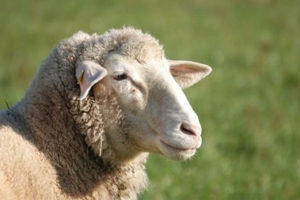Gangrenous mastitis, better known as blue udder, is the fear of every sheep and goat farmer. This is a very intense inflammation that is often caused by Staphylococcus aureus and Mannheimia Maemolytica, whereby the udder turns blue/black, becomes warm and hard. In addition, there is a very unpleasant smell. If any milk comes out at all, this is a very watery milk and/or it contains flakes.
It is a risk that is always present in the background within this branch of livestock farming. Usually in goats it occurs among yearlings, however this is not always the case. In sheep there is not a special age group where it occurs more or less, it can be related to various aspects, such as a non-fit sheep. It suffers more from a lack of “capacity” of energy for, for example, milk production, resulting in reduced resistance.
In addition, the Mannheimia often enters the throat of the lambs, which then infects the udder. This shows that it does not necessarily depend on the number of lambs and/or the age of the sheep.
The inflammation is such that if the sheep survives at all, half of the udder will rot off. However, in the vast majority of cases, the sheep does not survive the disease.
The reason that the sheep often does not survive the inflammation is due to the intensity of the disease and the impact the disease has on the sheep’s eating and drinking desire. The toxins spread quickly through the body in a short period of time, which can be visualized as blood poisoning in a human being. It also spreads rapidly through the bloodstream of the body. Combined with not eating and drinking, this leads to the death of the animal.
Those toxins that spread through the body at lightning speed, Rinagro may be able to do something for your sheep or goats.
The toxins poison the animal from the inside, causing it to stop eating and drinking, which can lead to death. However, one can also try to expel the toxins. They are anaerobic, which means they are environment dependent. They (survive) in a specific environment without oxygen. When Masecol is applied and introduced in the quarter, in the udder, an aerobic climate is created in the udder in which the toxin-producing bacteria cannot (survive) live. This treatment has successfully treated blue udder in several sheep on various farms.
Masecol should be added in adjusted dosage for this application. Before each new treatment, first try to empty the udder.
With blue udder, Masecol is administered with a dose of 50-75 ml in the udder (in the teat), in combination with pain relief (Novem). Our advice is 2 times a day for 2 days. Assess the sheep on day 3, see Do you see improvement or not When the picture is better, dose back to 25 ml, again 2 times a day for 2 days.
If your sheep reverts to a worse disease state when the dose is reduced, then dose more again (50-75 ml). Always keep the 2 days. Continue the 25 ml dose until the sheep becomes more active and/or eats well.
Do you want to know more? Contact us without obligation, we are happy to think along with you.
